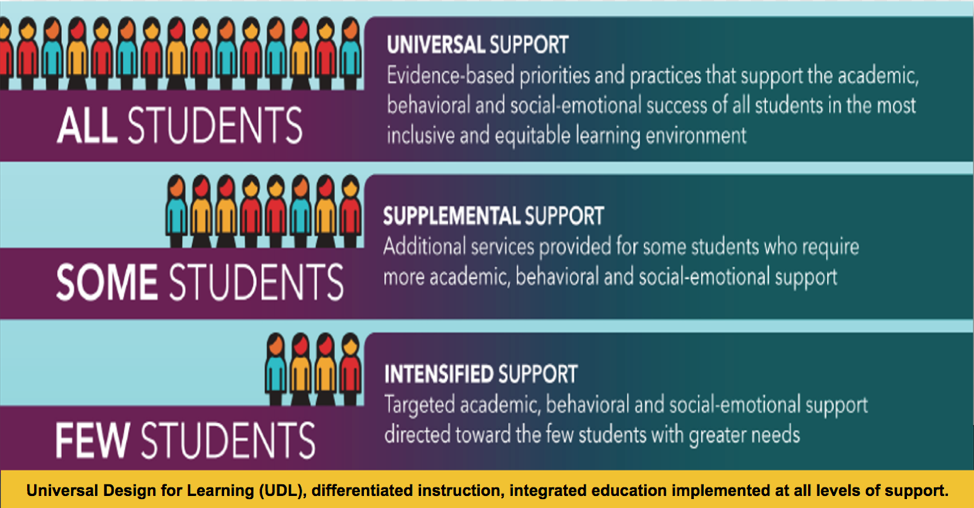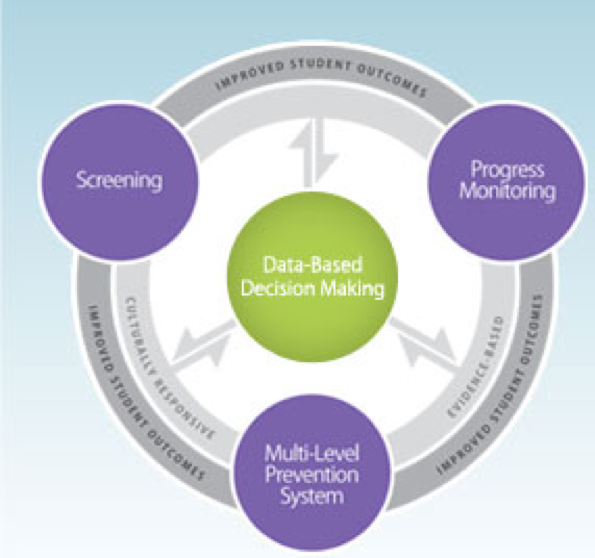Literacy & Language Arts

Definition
Literacy includes reading, writing, listening, and speaking. In this section we focus on the reading and writing aspects of literacy. This section begins with definitions, key ideas and resources and then later showcases specific practices that teacher educators can use to help their candidates support all students in literacy. Sample lectures, practiced based opportunities, assignments and activities are included.
Tiered Support In Literacy
Using the MTSS Framework in literacy: Many schools have been using multi-tiered systems of support in literacy for some time since RTI was typically used for reading. Learn more here about MTSS for academics.

Tier 1/Universal Supports: Tier 1 or Universal Supports for literacy instruction is considered to be the core curriculum, instruction aligned to the CCSS. Tier 1 includes lessons designed using the UDL framework and instruction differentiated for all students in the class. For EL this also includes ELD and any language supports needed to access the curriculum, SDAIE, SIOP. For students with disabilities this includes any modifications or accommodations needed to access the curriculum. Tier 1 also involves universal screening of students to determine which students need additional, Tier 2 or Tier 3, supports.
Tier 2/Supplemental or Strategic Supports: Tier 2 also called strategic or supplemental supports are considered to be additional supports in literacy. Tier 2 typically involves small group intervention for students for whom Tier 1 is not enough. This intervention is targeted and focuses on key literacy skills and typically would be separate interventions for reading and writing. Students are assessed at least monthly on skills being taught to determine progress and adjustments are made to intervention based on these assessments.
Tier 3/Intensive Supports: Tier 3 also called intensive supports is intensive intervention that is constantly informed by data. We use the model from the National Center on Intensive Intervention, data-based individualization. This process is guided by ongoing data that is collected weekly to inform and adapt the intervention. Interventions are validated by research and typically focused on only a one or two skills in order to intensify the intervention effectively.
READING INSTRUCTION AND INTERVENTION
Key Reading Components: Teacher candidates need to be provided explicit instruction in how to teach each of these key reading components. The Key Components of Reading presentation provides an overview of each key component and why it is important.
The Key Componets of Reading presentation includes the content of the reading instruction but what about the methods to teach these skills. Many students, including those with disabilities benefit from explicit, systematic reading Instruction.
The chapter linked here provides an overview of explicit instruction and is from the book Explicit Instruction: Effective and Efficient Teaching by Anita L. Archer and Charles A. Hughes. Copyright 2011 by The Guilford Press. It is part of the series, What works for special needs learners. The following series of videos provide examples of explicit instruction in the area of reading.
- Video – Elementary, Explicit Instruction, Archer, A., Hughes, C.
- Video – Secondary, Explicit Instruction, Archer, A., Hughes, C.
WRITING INSTRUCTION AND INTERVENTION
Teacher candidates need to be provided explicit instruction in how to teach each of these key writing components as well as the strategies they need to teach students for writing independently. The key components of writing presentation provides an overview of each key component and why it is important. The following list of videos complement the writing instructions presentation:
- Instructional Strategies for Teaching Writing to Elementary Students
- Teaching Elementary School Students to Be Effective Writers-- Part 3
- Strategies to Improve Secondary Students Writing-Webinar

Assessment
Assessment and data-based decision making is an essential component of an MTSS model and an essential component of delivering effective inclusive literacy instruction. The graphic below shows the data based decision making process. "Data analysis and decision making occur at all levels of RTI implementation and all levels of instruction. Teams use screening and progress monitoring data to make decisions about instruction, movement within the multi-level prevention system, and disability identification (in accordance with state law)."

The presentation Using Assessment to Guide Instruction and Intervention in a MTSS Model provides an overview of the types of assessments that are essential in an MTSS model and that guide inclusive literacy instruction. Examples of each type of assessments is provided.
The National Center on Intensive Intervention provides “Tools Charts” for academic screening and progress monitoring. The tool charts provide information on technical adequacy, including classification accuracy and growth standards, and usability.

Assignment/Activities
The two modules: 1) Using Data-Based Individualization To Intensify Instruction and 2) Collecting and Analyzing Data for Data-Based Individualization, provide more detail about data-based interventions and can be used in courses to support lecture and activities related to Tier 3 intervention and using data to drive instruction.
Dual Credential Program Activity
Elementary Activity for Students with Significant Needs

Additional Resources
Articles
- Baker, D.L., Richards-Tutor, C., Sparks, A., & Canges, R. (2018). Review of Single Subject Research Examining the Effectiveness of Interventions for at Risk English Learners. Learning Disabilities Research & Practice, 33, 64-74.
- Richards-Tutor, C., Baker, D.L., Gersten, R., Baker, S., & Smith, J.M. (2015). The Effectiveness of Reading Interventions for English Learners: A Research Synthesis. Exceptional Children, 82, 144-169.
- Scammacca, N.K., Roberts, G., Vaughn, S., Stuebing, K.K. (2015). A Meta-Analysis of Interventions for Struggling Readers in Grades 4–12: 1980–2011. Journal of Learning Disabilities, 48 (4), 369-390. doi: 10.1177/0022219413504995
- Gersten, R., Haymond, K., Newman-Gonchar, R., Dimino, J., Jayanthi, M. (2019). Meta-Analysis of the Impact of Reading Interventions for Students in the Primary Grades. Journal of Research on Educational Effectiveness.
- California Commissin on Teacher Credentialing (2019). Literacy Teaching Performance Expectations Adopted by the Commission.
Books
- Blackburn, B.R., & Witzel, B.S. (2018). Rigor in the RTI and MTSS Classroom. New York, NY: Routledge
- Burns, M.K., Riley-Tillman, T.C., & Rathyon, N. (2017). Effective School Interventions, Third Edition: Evidence-Based Strategies for Improving Student Outcomes. New York, NY: Guilford Press.
- Gunning, T.G. (2020). Creating Literacy Instruction for All Students. 10th ed. New York, NY: Pearson.
- Reed, D., Wexler, J., & Vaughn, S. (2012). RTI for Reading at the Secondary Level: Recommended Literacy Practices and Remaining Questions. New York, NY: Guildford Press.
Videos
- Instructional Strategies for Teaching Writing to Elementary Students
- Teaching Elementary School Students to Be Effective Writers-- Part 3
- Strategies to Improve Secondary Students’ Writing Skills: Lessons from a WWC Practice Guide
Websites
- IRIS Module: Improving Writing Performance: A Strategy for Writing Persuasive Essays
- IRIS Module: RTI Reading Instruction
- Explicit Instruction: Video Elementary
- Explicit Instruction: Video Secondary
- Literacy Teaching Performance Expectations
IES Practice Guides
- Foundational Skills to Support Reading for Understanding in Kindergarten Through 3rd Grade
- Teaching Secondary Students to Write Effectively
- Teaching Elementary School Students to Be Effective Writers
- Teaching Academic Content and Literacy to English Learners in Elementary and Middle School
- Improving Reading Comprehension in Kindergarten Through 3rd Grade
- Improving Adolescent Literacy: Effective Classroom and Intervention Practices

